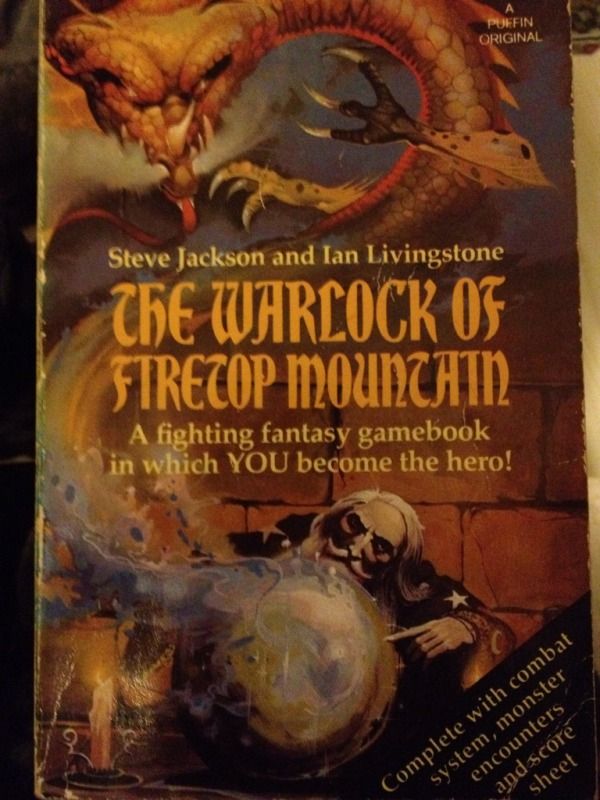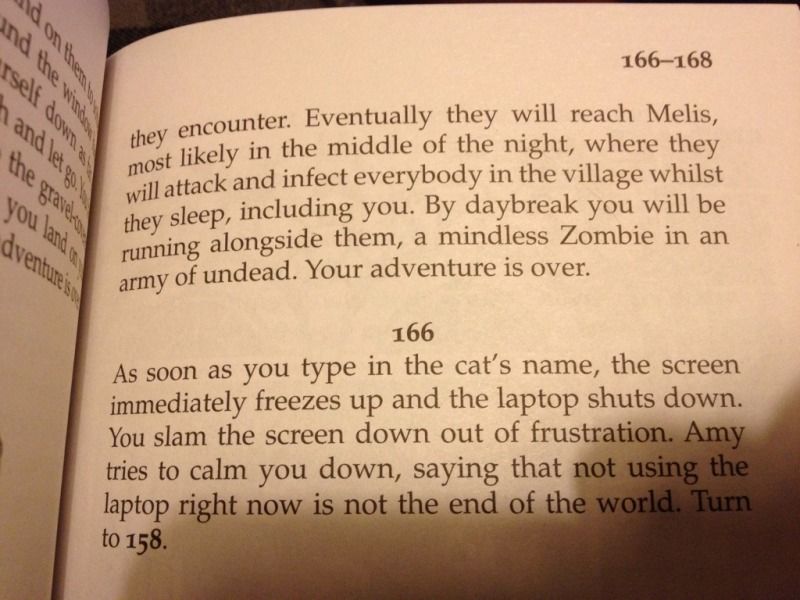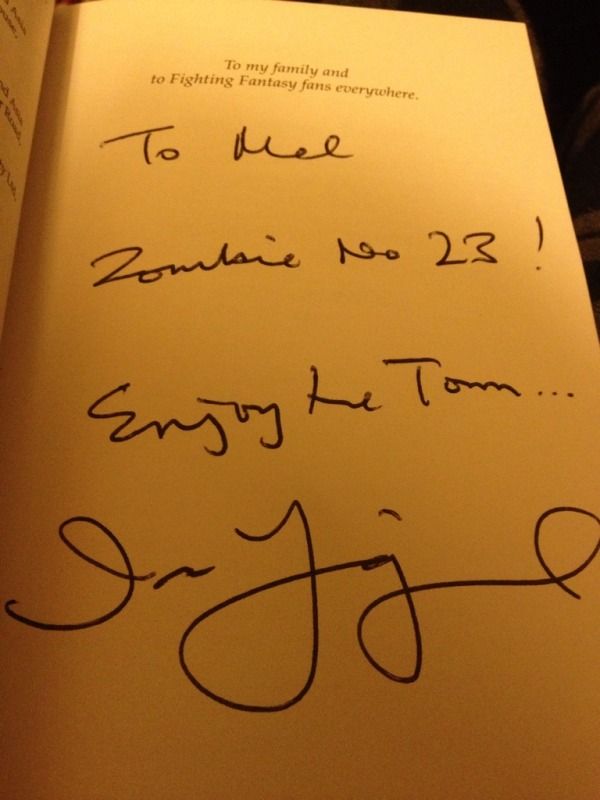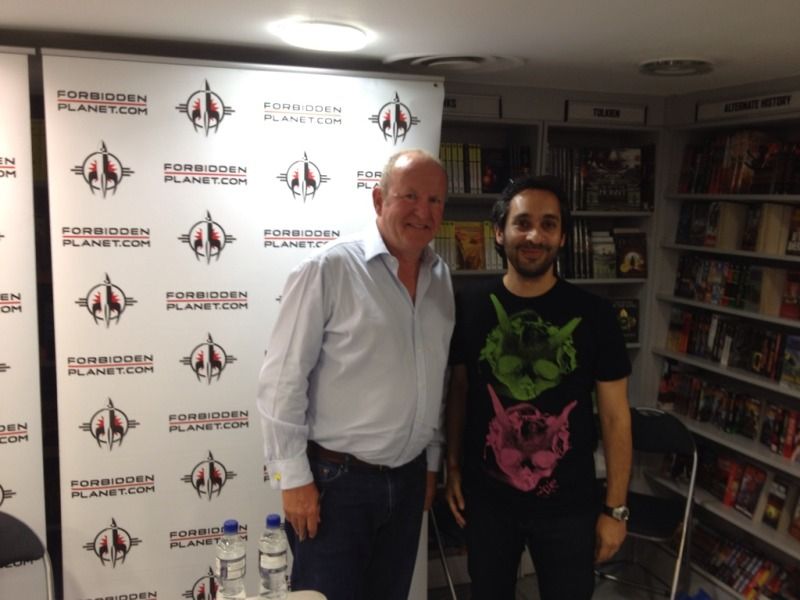1982
I distinctly remember being at school and one of my friends shoved a book in my hand, possibly Nick or Luke. I can’t remember who exactly, because the book was that exciting, their presence faded into insignificance and the only memory I have is of the endorphin hit of happiness as I feverishly got to grips with this new concept presented before me. It had a picture (cover art by Peter Jones) of a sultry smoking dragon on the front, writhing out from a unsettlingly stern faced wizard’s crystal ball.
 My duffed up copy of Warlock
My duffed up copy of Warlock
That book was The Warlock of Firetop Mountain, by Steve Jackson and Ian Livingstone. As the blurb on the front says “A fighting fantasy gamebook in which YOU become the hero!”. Unusually for any book, it was written in the second person, because the reader was directly influencing and interacting with the story path through a non-linear multi-choice system. Every choice made is then numbered, from choosing whether to try and sneak past a sleeping hobgoblin, or attacking him, going east or west, bashing a door down, or picking a lock. You flick backwards and forwards through the numbered sections of the story, depending on the options you choose. And there was also an element of randomness and fortune. So, two dice, a pencil and an eraser were essential equipment for any journey into the mysteries of the book.
You rolled dice to define the characteristics of your character before you set off. SKILL, STAMINA and LUCK were key to your characters survival. If your STAMINA ran out, through combat (also dictated by rules involving dice throws) or otherwise (e.g – a spiked pit you might stumble into), you were dead, you would have to start again. A high SKILL was important, as that made it more likely to defeat monsters or perform tasks. And a high LUCK was important, as there were times when luck was key to say noticing an important fact, or sneaking past a powerful enemy. You could pick up gold, provisions, keys, weapons and items, some of which might be useful, some might be useless. All of this information you scribbled on your character sheet.
What complemented the book was also the illustration by Russ Nicholson. For example this illustration of two orc’s drinking grog. The incidental detail is astounding, the shading, the scoring of the table by the orc’s fingers, the vacant drunk expressions (looks a bit like some of the pubs I go to in north London). All the way through, the standard is incredible, bringing the story further to life.

Both Steve Jackson and Ian Livingstone have gone on and become fabulously successful in Role Playing, Tabletop Wargaming and Computer Game fields, but for a group of people of a certain age (35-45), we all fondly remember Fighting Fantasy.
After Warlock, many more books followed, my favourites I think were Forest of Doom, it had an eerie nightmare emptiness about it, punctuated by tough encounters with brutal monsters. And of course the classic Deathtrap Dungeon, which was really hard to complete, that claustrophobic feeling of being surrounded, unable to retreat and having little hope as various beasts or traps killed you in a variety of ingenious, frustratingly amusing or bloody ways. Baron Sukumvit was a right git.
2012
And thirty years later, a new book has been written by Livingstone, to commemorate this landmark. It’s set in a contemporary horror setting. Called “Blood of the Zombies” it puts you in the role of someone trying to prevent a zombie apocalypse. it’s gory, fast paced and fun. And the best bit for me is that I was one of a select few twitter followers who won an opportunity to have my name appear in it! (teeny spoiler below).

“Melis” is a village/town which appears in the book. Which I am massively excited about. I queued up at Forbidden planet to get it signed too. I’m Zombie no 23. “Enjoy the town…” writes Ian.

Below, two giants of computer science. Well, one giant and one dwarf.

As Ian has stated in recent interviews, Blood of the Zombies’ art nods to both the past but also today’s teenagers, it’s universal really. But I haven’t played it to any great depth yet as I want to keep my signed one pristine, I’m waiting for the iPhone app! (imminently coming out). No spoilers, other than the reference to “my” town in the photo above. Which neatly brings me onto computer games.
As has been oft reported, Fighting Fantasy were the book equivalent of an adventure computer game and the influence on modern computer games is not to be underestimated. So I’d like to thank Ian Livingstone, I guess without his intervention, the mystery of Computer Science may have been lost on me. Role Players also like computers and computer games. Not sure why, we just do, computers, geekiness and role playing are the holy trinity of awkward teenagers. So I studied computer science. Admittedly there were hardly any girls on my university course and I was pretty shit at programming, so at times I was just this bewildered socially incompetent nobhead with no girlfriend, but I’m happy I played the long game now :) I’ve forged a decent career in IT Services and this allows me to make such bourgeois decisions as rebuying (I can’t find my original copy) a duffed up 1982 copy of Warlock for posterity and for that nostalgia hit. It arrived the other day. It still has the rubbed out scribbles of some contemporary of mine in the character sheet section.

It just wouldn’t have been right to buy a brand new copy. Therefore my collection spans a true 30 years now.
If you haven’t read any Fighting Fantasy books, try them. And remember. YOU are the hero. Blood of the Zombies (with my name in it hehe) – OUT NOW !
3 comments:
Love that there is a town called Melis!
This is the coolest thing I've seen in ages!
I also got up to London for the signing, I wrote it up a while ago on my blog at http://fightyourfantasy.blogspot.co.uk/ When I do my post on Blood of the Zombies, shall I give you a shout-out?
Marsten, please feel free to shout me out. Just checked your blog and really enjoyed reading it.
Post a Comment